Should We Be Transparent about the Realities of Age and Female Fertility?
 In part thanks to celebrities, our general consensus leans toward the notion that women can get pregnant well into their 40s, maybe even their early 50s, without any kind of assisted reproductive care.
In part thanks to celebrities, our general consensus leans toward the notion that women can get pregnant well into their 40s, maybe even their early 50s, without any kind of assisted reproductive care.
Of course, some celebrities have been open and honest about having children at this age, discussing their use of an egg donor and / or gestational surrogate and helping to educate the masses on what those processes are like in reality. However, not everyone (celebs or not) is as transparent, and this can be misleading or even painful to women struggling to conceive.
An argument for better reproductive transparency (while respecting privacy)
Ultimately, it is up to individuals to decide when and how much they wish to share about their family-building journey. This choice should be respected and honored without pushing for details that are private. This rule of thumb should also extend to those individuals who often make their private life public (e.g., celebrities).
Collectively, we’re fortunate that many public figures are comfortable sharing details about their family-building experience. Chrissy Teigen, for example, has been very open about using in vitro fertilization (IVF) with husband John Legend to have their two children, daughter Luna and son Miles, including a failed first cycle. Sarah Jessica Parker’s twin daughters were delivered via a gestational surrogate, and Gabrielle Union recently welcomed her daughter Kaavia with husband Dwyane Wade with the help of a gestational surrogate after experiencing more than 10 miscarriages.
Their transparency has helped us make tremendous strides in our societal view of women, fertility, and aging. Acknowledging the use of fertility treatments and third-party reproduction demonstrates that a) many couples struggle to conceive without fertility care and b) sometimes even with fertility care, an egg donor, sperm donor, and / or surrogate is needed. When news breaks of a celebrity in her late 40s or 50s giving birth, many fertility specialists will point out to their patients that statistically, it’s unlikely a child could be conceived at certain ages without treatment or a third party – information often left out of magazine articles and social media posts.
Understanding age and female fertility
A woman’s fertility typically peaks in her 20s when she is most fertile, and then declines more quickly after age 35. Of course, this is not to say that a women in her 40s couldn’t conceive naturally, but it’s simply less likely than it seems. Understanding how fertility works for the female partner is important because women are unfairly put under pressure to consider their family-planning goals much earlier in life than their male partners are. Third-party reproduction services can play a core role in modern family building for couples in different age brackets, including LGBT families.
If you have questions about third-party reproduction, including egg donation and surrogacy services, we encourage you to contact Fertility Source Companies’ Case Managers today. We understand that transitioning from trying to conceive on your own to using a third party can be challenging for many reasons, and our experienced staff can help guide you through every step of the process.


